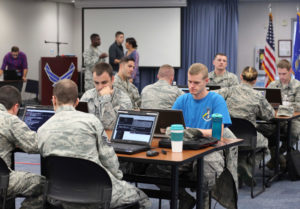So from time to time, I like to provide an opinion on things. My friends that know me well would probably say that this is an understatement, but I wanted to try to attempt to provide a little insight on the recent NGA West Corp of Engineering Study that was released the other day from the perspective of an Illinoisan.
I have lived in Illinois almost my entire life. I have a vested interest in the Metro East side of St. Louis; so yes I have a bias. You can call me on that. I am not, however, a Cubs fan.
This highly anticipated study, probably not as much of a concern to the general public, was released on Thursday, October 15th. It reviews the four sites NGA is currently evaluating for the next location of its NGA West campus. Cities including St. Louis, Mehlville, Fenton and O’Fallon/SAFB (St. Clair County) are bidding to become the next Western home of an agency that most people don’t even know what they do.
NGA, or the National Geospatial-Intelligence Agency, is the nation’s primary source of geospatial intelligence, or GEOINT for the Department of Defense and the U.S. Intelligence Community.
As a DOD combat support agency and a member of the IC, NGA provides GEOINT, in support of U.S. national security and defense, as well as disaster relief. GEOINT is the exploitation and analysis of imagery and geospatial information that describes, assesses and visually depicts physical features and geographically referenced activities on the Earth (lifted from nga.mil).
What comes with the winning of the NGA West competition?
An estimated 3,000 jobs. That does not include the millions of dollars that construction of this facility will pump into the local economy. A temporary spike, but a spike nonetheless. Infrastructure will evolve around this facility as the workers look to have their dry cleaning, haircuts, and daily sustenance needs met. I am just being real here; no one will stay on campus to get those things. Just think of the gas station economy surrounding a facility with 3,000 jobs. This is a big deal.
With any high profile government decision comes things like Environmental Impact studies. This is what the report covered on Thursday. The Kansas City Missouri Corp of Engineers provided the results of a study they conducted over the last year that outlines the following areas:
- Purpose and Need – Why are we doing this? Why is it needed?
- Proposed Action – What is the government proposing to do? What alternatives are they considering?
- Affected Environment – What is the current state of the environment?
- Range of Alternatives – What are the options, including a No Action Alternative?
- Environmental Consequences – What are the environmental impacts resulting at each site?
I read through the study. I can’t say I understood everything in it, but as a college-educated person, I believe I got the gist of things. What I found was a little disappointing; in my opinion.
A few of my highlights:
- Crime rate was not taken into account. I think this matters from an employee safety/liability standpoint. You are not going to attract high-quality employees to an area that makes people feel unsafe. How that wasn’t analyzed in the Affected Environment section of the impact study is beyond me.
- The magnitude of displacing or relocating people and businesses in the North St. Louis City site was drastically reduced. I don’t think that it can be understated the cost from a financial but also mental/spiritual side when you uproot people and businesses. This was all swept aside by the following statement: “However, this impact is not high and adverse in light of the Missouri relocation statutes (Sections 523.200–215, RSMo, 2014), which also meet the requirements of the federal Uniform Relocation Assistance and Real Property Acquisition Policies Act of 1970, as amended.” So because Missouri has laws in place that meet Federal guidelines, forcing people out of their homes and businesses is not that big of a deal. Sarcasm was intended in that last statement. Did I mention how the St. Clair County land is FREE, expandable (allowing NGA to grow — more job creation), and doesn’t require displacement of any citizens or businesses?
- The magnitude of the historical site investigation and airspace reconfiguration (?) was blown way out of proportion for the St. Clair County (O’Fallon/SAFB) location. These issues, if you would actually call them that, are very minor in the grand scheme of things but seemed to be a “red flag” within the Corp study.
- Proximity to the workforce. I think this should have been talked about and it is not something that can be swept under the rug. Where does something like this go? Maybe in the Affected Environment? When considering the best place to put the new campus, I think direct proximity with a US Air Force base that trains military and civilian personnel that meet and exceed the requirements to work at NGA, is a significant discriminator. The work is directly related. Sure the study mentions that SAFB is the 4th largest employer in the area, but worker skill set was not analyzed as part of the viability of the areas.
- Proximity to security/secure environment. For any national intelligence agency, security is a predominant concern. The Affected Environment in St. Clair Country could provide a more secure location with regards to tying into base infrastructure and capabilities. No other site provides this that I know of; as it was not discussed.
- The infrastructure of the areas was also downplayed, and this is something that I felt more information was needed on all sites. Since I work out at SAFB, I know that the location has a decent in and out traffic flow, but as the study indicated, a traffic light is needed to help with that flow. This was not fully flushed out in the study and only someone with knowledge of the area would know what I know. The level of detail here for all locations was lacking. For instance, it wasn’t noted that a new ramp directly off of Highway 64 was being built that would allow employees of NGA direct access to the site from the highway; ala Monsanto or Boeing on the Missouri side. That has to be a big benefit in the considerations. Another consideration is access to mass transit (SAFB has a MetroLink stop, the St. Louis location has bus service).
Overall, I felt like the study reeked of a whitewashing. I can’t argue that building in North St. Louis would not help the economy there and that it might be needed, but anywhere this campus is built will help the local economy. It’s out of the scope of this report, but what is best for the taxpayer needs to be at play here. I would like to see the competition be clean and fair for all parties; and that is why I decided to voice my opinion, as this doesn’t seem like a fair competition if the intent of the Impact Study is to “impact” the decision.
Feel free to make your own opinion after reading the study here: Next NGA West | National Geospatial-Intelligence Agency
Thanks for reading.
Nick Powers


